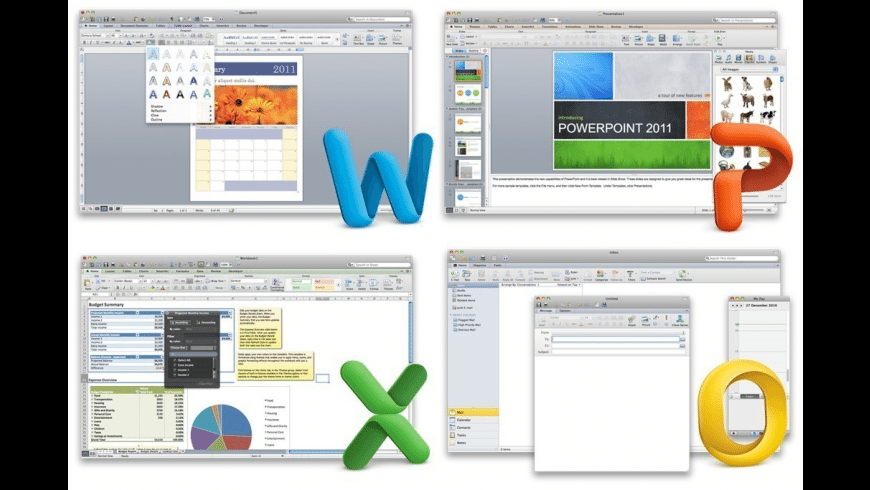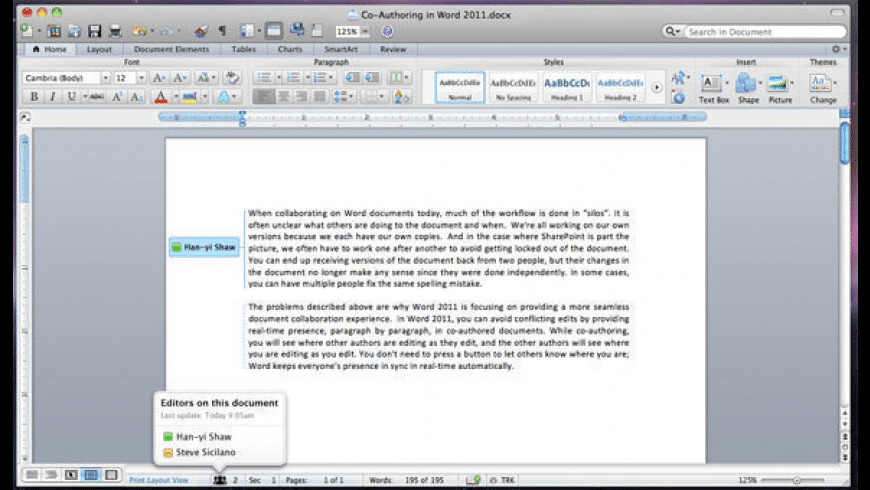Open the Microsoft Office for Mac 2011 14.1 Update volume on your desktop. This step might have been performed for you. To start the update process, in the Microsoft Office for Mac 2011 14.1 Update volume window, double-click the Microsoft Office for Mac 2011 14.1 Update application, and follow the instructions on the screen. CVE-2011-1276: Buffer overflow in Microsoft Excel 2002 SP3, 2003 SP3, and 2007 SP2; Office 2004 and 2008 for Mac; Open XML File Format Converter for Mac; Excel Viewer SP2; and Office Compatibility Pack for Word, Excel, and PowerPoint 2007 File Formats SP2 allows remote attackers to execute arbitrary code or cause a denial of service (memory corruption) via a crafted Excel spreadsheet, related.
Microsoft Office for Mac 2011 is the most recent version of the Microsoft Office productivity suite for Mac OS X. It is the successor to Microsoft Office 2008 for Mac and is comparable to Microsoft Office 2010 for Windows.
Microsoft Office 2011 includes more robust enterprise support and greater feature parity with the Windows edition. Its interface is now more similar to Office 2007 and 2010 for Windows, with the addition of the Ribbon. A new version of Outlook, written using Mac OS X’s Cocoa API, returns to the Mac for the first time since 2001 and has full support for Exchange 2007. It replaces Entourage, which was included in Office 2004 and 2008 for Mac. Support for Visual Basic for Applications macros returned after having been dropped in Office 2008.
In addition, Office 2011 supports online collaboration tools such as Windows Live SkyDrive and Office Web Apps, allowing Mac and Windows users to simultaneously edit documents over the web.
Office for Mac 2011 has a number of limitations compared to Office 2010 for Windows. It does not support ActiveX controls, OpenDocument Format, or right-to-left languages such as Arabic, Persian, and Hebrew. It also cannot handle attachments in Rich Text Format e-mail messages sent from Outlook for Windows, which are delivered as winmail.dat attachments.
Perform common tasks, fast. Office for Mac 2011 features a dynamic ribbon interface that puts commonly used features right where you need them, in Word, Excel, PowerPoint, and Outlook for Mac. We’ve translated the ribbon for the Mac to help streamline the creation of polished documents, presentations, spreadsheets, and e-mail. Office for Mac 2011 feels familiar, whether you are a longtime Mac user or use Office on a PC
MS Office 2011 Language Support
“Australian, Austrian, Belgian, Brazilian, British, Bulgarian, Canadian, Croatian, Czech, Danish, Dutch, Dvorak, Estonian, Faroese, Finnish, French, German, Greek, Hawaiian, Hungarian, Icelandic, Inuktitut, Irish, Italian, Latvian, Lithuanian, Macedonian (F.Y.R.O.), Northern Sami, Norwegian, Polish, Portuguese, Romanian, Russian, Serbian, Slovak, Slovenian, Spanish, Swedish, Swiss French, Swiss German, Turkish, U.S., Ukrainian, Unicode Hex Input, and Welsh. You can also use the following Mac OS X input methods: Hangul, Kotoeri, Murasu Anjal Tamil, Simplified Chinese, and Traditional Chinese.”

System Requirements:
- A Mac computer with an Intel processor
- Mac OS X version 10.5.8 or later
- 1 GB of RAM or more
- 2.5 GB of available hard disk space
- HFS+ hard disk format (also known as Mac OS Extended or HFS Plus)
- 1280 x 800 or higher resolution monitor
- DVD drive or connection to a local area network (if installing over a network)
- Safari 5 or later recommended


Description of the security update for Office for Mac 2011 14.7.3: April 11, 2017
This update fixes critical issues and also helps to improve security. This security update provides the latest fixes for Office for Mac 2011.
Office For Mac 2011
Screenshot:
